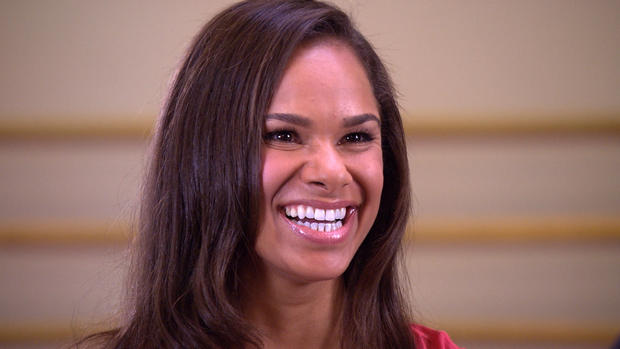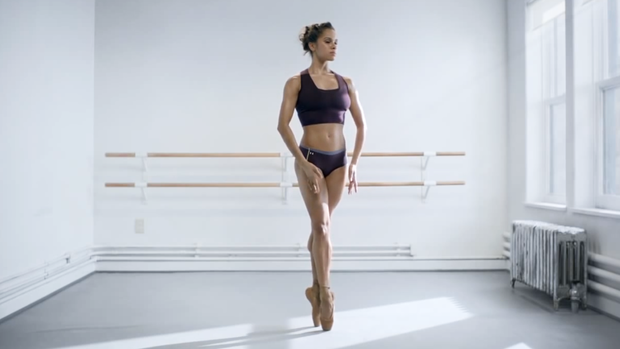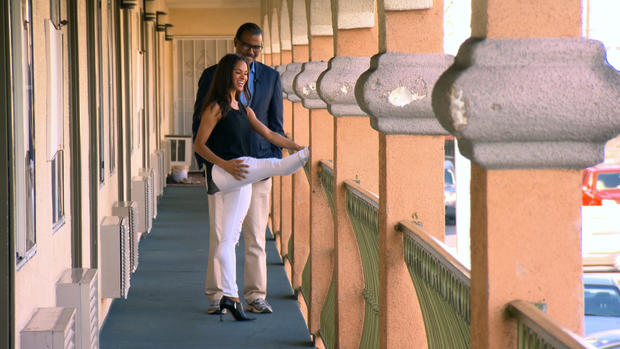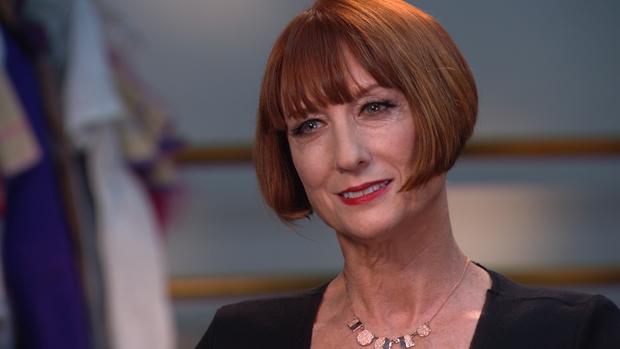Misty Copeland
The following script is from "Misty Copeland" which aired on May 10, 2015, and was rebroadcast on August 23, 2015. Bill Whitaker is the correspondent. Patricia Shevlin, producer.
Unless she's on her toes, Misty Copeland is just a little over five feet tall, but she's a towering figure in the world of ballet -- a top dancer in one of the top companies; American Ballet Theatre. She's been called a prodigy, a breath of fresh air. She wants to blow the cobwebs out of the stuffy world of classical ballet and open the doors to everyone. Misty Copeland is the embodiment of the American dream. She grew up poor, didn't hear classical music until she was a teenager, she's an African American in a profession where there are few. At 32, she has reached the top of her profession. As we reported earlier this year, when Misty Copeland began, one dance company told her she would never make it in ballet. Boy, were they wrong.
Misty Copeland will tell you; she's never more alive than when she's onstage, on her toes, her athleticism and grace on full display. She can leap through the air. She can spin on a dime. She can make you believe she's a swan by a lake.
Bill Whitaker: You feel comfortable up there?
Misty Copeland: Yes. Something happens when you feel that energy and excitement from the audience. And you do, I don't know, four pirouettes. You jump higher than you ever have. And it's just this really magical thing that happens in those moments.
She performs to sell-out crowds on grand stages across the country.
"Something happens when you feel that energy and excitement from the audience....You jump higher than you ever have. And it's just this really magical thing that happens in those moments."
But it was this commercial for the sportswear company, Under Armour, that introduced her to a new audience.
About six and a half million people see live ballet every year. Almost 8 million viewed this commercial online. A different audience found her when she danced with pop star Prince.
And there she was on the cover of time magazine as one of the 100 most influential people.
Stage Door: "Hi Misty!"
We were at the stage door after a performance in Orange County, California. She was mobbed like a rock star.
Stage Door: "Can you sign my ticket please?"
Misty Copeland lives in New York City. She feels most at home on the stage of the Metropolitan Opera House, where American Ballet Theatre performs. It's 3,000 miles and a world away from where she began. If there is such a thing as the wrong side of the tracks, that's where Misty Copeland grew up. She, her divorced mother and five siblings moved around like nomads. Down on their luck, they ended up here at this motel on a busy street in Gardena, California -- the whole family piled into two rooms. She hadn't been back in almost two decades until she returned with us.
Bill Whitaker: So what's it like seeing this again?
Misty Copeland: Um, it brings back so many feelings and memories.
Bill Whitaker: Good? Bad?
Misty Copeland: A little of both. But just a really hard time. Because I was so embarrassed about it.
Bill Whitaker: Living here?
Misty Copeland: Yeah, I think that's why when I saw the sign I was expecting it to be so much bigger, because in my mind at that time it was just like this thing that was so huge that I'd wanted to hide from.
She'd play with her brothers and sisters on the balcony. She imagined the railing outside their rooms to be her private studio.
Bill Whitaker: You said you would actually use these bars as your Ballet Barre?
Misty Copeland: Yeah, I would. I remember ...
Bill Whitaker: Like what? Can you do it?
Misty Copeland: Yeah, I would stretch out here and - do my whole - I mean it's actually a really good barre. Do my whole class out here. It was a - it was a nice little, little escape.
The graceful dancer we see today stumbled into ballet. A teacher at school noticed her fluid movement and suggested she check out the after school ballet program at the San Pedro Boys and Girls Club. Misty Copeland was 13 years old.
Bill Whitaker: That's kind of old for someone to just start taking ballet.
Misty Copeland: It is, yeah.
Bill Whitaker: So, what was it like when you first walked in to a ballet studio?
Misty Copeland: You know, my first ballet class was on a basketball court. I'm in my gym clothes and my socks trying to do this thing called ballet. I didn't know anything about it.
Cindy Bradley: The first time I saw her she was sitting high on the bleachers and I had ...I asked her to come down and join us. And it took a lot of coaxing.
The coaxer was Cindy Bradley, the ballet instructor, who would change Misty Copeland's life. You might call it luck. Cindy Bradley says it was magic.
Cindy Bradley: I've never been able to put it in to words exactly, the feeling that I got. But it was almost like a vision of what she could be one day.
Bill Whitaker: What is her talent?
Cindy Bradley: She had the perfect feet and she was flexible. I knew that she was going to be one of the greats.
Bradley says Misty Copeland had a gift. If she saw a step, she could master it. It takes most ballerinas more than three years to get up on their toes. It took Misty Copeland three months.
Misty Copeland: Once I was a part of it, I couldn't get enough of it. So, every day I came into the ballet studio, it was like, "Oh my gosh, I'm going to learn something new today. What is it going to be?" And just soaking it all up. I just never experienced anything like that.
Cindy Bradley: Yeah, we had to cram in a lot of lessons. We would work day and evenings to - to make up the time.
The training got so intense and time-consuming, Cindy Bradley says one evening Copeland's mother called and told her it was all too much, that the ballet lessons had to end and asked her to drive her daughter home to the motel.
Bill Whitaker: And what did you think when you saw where she lived?
Cindy Bradley: I was a little shocked. And I just knew that dance was going to get her out of there. So, after driving partway home, I turned around and knocked on the door and asked her mother to let her come and live with us.
Misty Copeland: And I remember it so vividly, just Cindy coming and speaking with my mother and them making the decision right there on the spot for me to come and live with them. And I just packed up my little backpack, everything I had, put it in there ... and I left.
Left the grim motel for a comfortable San Pedro condo, where she lived with Cindy Bradley, her husband Patrick and son Wolf as part of the family.
[Misty Copeland: "Oh my gosh."
Wolf Bradley: "What is it?"
Misty Copeland: "It's a camera."]
Almost three years under Bradley's wing, Copeland began to blossom, to win awards, to gain attention... she says her mother saw her changing and feared she was losing her daughter and finally demanded she come home for good.
Misty Copeland: I did not want to lose ballet. And the thought of losing that and coming back and living at this motel was something that I just couldn't let happen. It was like watching my future slip away.
So, at the self-conscious age of 15, at the urging of Cindy Bradley, Misty Copeland went to court to seek independence from her mother. The local prodigy's legal drama made headlines.
Misty Copeland: It got to the point where it was so nasty that...
Bill Whitaker: Nasty and public...
Misty Copeland: That was probably the hardest part. Was that it was so public.
After two bitter months, Misty Copeland dropped her bid for independence, left her life with Cindy Bradley and moved back home with her mother.
Misty Copeland: "I just want keep dancing and hope that everyone's happy."
Ballet, which was her lifeline, became her escape hatch. The next year she won a scholarship to American Ballet Theatre's summer program for gifted young dancers in New York. For the second time she was spotted by someone who would change her life. This time, it was American Ballet Theatre Director, Kevin McKenzie.
Bill Whitaker: What caught your eye?
Kevin McKenzie: She has a proportion to her body and she has a response to music a visceral response to music, and a coordination that are all the ingredients of a major ballet dancer.
She's now a soloist, one of the featured performers at American Ballet Theatre, dancing in the footsteps of its legends, like Mikhail Baryshnikov.
Kevin McKenzie: I used to wonder, as an African American, if she was aware of the symbol she could possibly be?
Bill Whitaker: What do you mean?
Kevin McKenzie: You know, if she goes where she can go, she's going to be a very big symbol. This is a very big deal here.
A big deal, because there are so few black dancers in major ballet companies.
Misty Copeland: They're being told they don't fit in, they won't have a successful career, they don't have the bodies...
Misty Copeland: Even to this day, I hear that I shouldn't even be wearing a tutu. I don't have the right legs, my muscles are too big.
Bill Whitaker: What do you think when you hear that?
Misty Copeland: There are times when I believe it, when I start to question, you know, maybe it - maybe I'm seeing myself in a different way than the people in the audience see me, 'cause to me, I think I look like a ballerina and I feel like a ballerina. But maybe I'm not seeing what other people are seeing.
She's changing perceptions one step at a time. Misty Copeland is powerful, elegant, determined. It takes a lot of effort to look this effortless.
We saw her drive one night in Orange County. Amid the stage hands and exotic creatures we found Misty Copeland tying up, lacing up, making up. She was relaxed, but focused.
Misty Copeland: There's maybe one part in my solo that's - that's a little bit difficult for me.
Bill Whitaker: What part is that? I'll be looking for it.
Misty Copeland: Now I don't want to tell you.
But she did tell us. It's hopping on her toes. It looked alright to us, but after the scene, we could see the frustration on her face.
Bill Whitaker: So what were you unhappy with?
Misty Copeland: Just that thing we were talking about, the hops.
She put on her stage face and finished the performance. She might look like a music box doll, but Misty Copeland is tough as nails. Three years ago, in rehearsal for her first starring role as the mythical firebird, she didn't tell anyone her left leg was hurting badly.
Misty Copeland: By the time the show came, it hurt just to walk and the pressures of knowing how many people were coming out to support, how many people in the African American community, for the first time that understood what this meant to have an African American woman in this position, doing this role with American Ballet Theatre at the Metropolitan Opera House. So it was like, "I'm doing this!"
Critics hailed her performance, but it almost ended her career.
Bill Whitaker: Turned out to be a very severe injury?
Misty Copeland: Yeah. I had six stress fractures in my tibia and three of them were almost full breaks through the bone and I was being told by several doctors I would never dance again.
But seven months later, with a plate in her leg, she was back on her toes. She had to build her way back, but soon was in top form dazzling audiences once again. Ballet has lifted Misty Copeland from poverty, over assumptions about race and through injury. But she wanted it to take her higher. She dreamed of making the leap to principal dancer, the most elite position in the ballet world.
Bill Whitaker: Do you see that in your future?
Misty Copeland: For the first time ever, I do.
She got her wish. This summer, Misty Copeland became the first African American ballerina to be named principal dancer at American Ballet Theatre. Kevin McKenzie made the decision after seeing her in starring roles this year.
In April, with the Washington Ballet at the John F. Kennedy Center for the Performing Arts, she performed the most famous ballet of all - Swan Lake. It was the first time two African Americans danced the lead roles for a major company. It took her one step closer to her other goal of making ballet in America look like America - on stage and in the audience
Recording in part at
The John F. Kennedy Center for the Performing Arts
David M. Rubenstein, Chairman
Deborah F. Rutter, President




